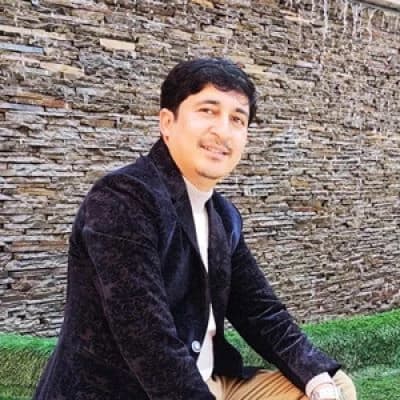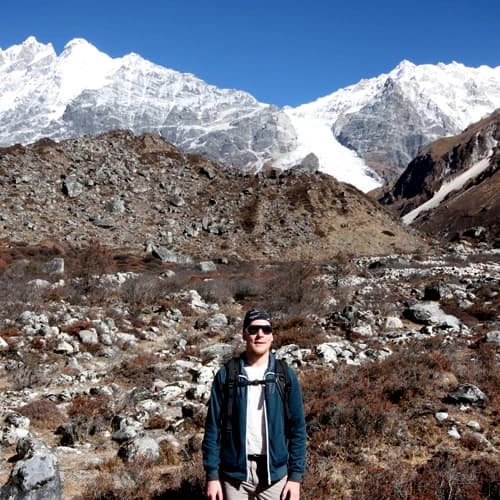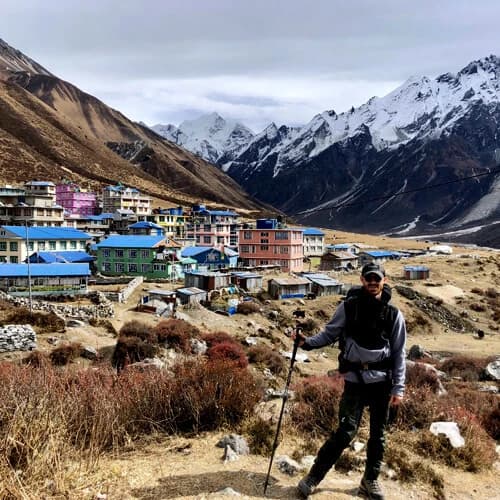Are you thinking about trekking through Nepal's breathtaking Langtang Valley? Are you curious about the cost of the Langtang trek in 2025? This blog offers a detailed cost breakdown to help you budget smartly for one of the most affordable and scenic treks in the Himalayas.
Langtang Trek Cost Breakdown
How Much Does the Langtang Trek Cost in 2025, 2026?
Langtang Circuit Trek in 2025 remains one of Nepal's most scenic and budget-friendly treks. A 7–10 day trek can cost between $500 and $900. This includes permits (TIMS and Langtang National Park entry fees), guide and porter service, food, accommodation, round-trip transportation from Kathmandu to Syabrubesi, and airport drop-off and pickup. The exact cost differs based on group size, level of comfort, and whether you travel independently or through an agency.
Food and accommodation along the trail are not pricey, with tea houses ranging from $5 to $10 per night and meals ranging from $4 to $7 on average. The tips/ gratitude is approximately $25 to $30 per day for a guide and $15 to $20 per day for a porter. Solo trekkers can be a budget-friendly option. However, one must be highly familiar with the route and prioritize their safety as the Langtang region is remote and less traveled than other routes.
Having said that, if you're looking for a culturally interesting but moderately challenging trek with outstanding mountain views, then Langtang Trek is a great choice. For those who budget wisely, travel in groups, and plan well, the Langtang Trek offers a great Himalayan experience. It combines rich Tamang heritage, traditional mountain villages, and serene landscapes that feel both remote and welcoming. Whether you're a first-time trekker or a seasoned hiker, Langtang provides the perfect balance of accessibility, adventure, and authenticity.
Factors Affecting the Langtang Trek Cost
There are several key factors that influence the total cost of the Langtang Trek in 2025. The most significant is whether you trek independently or take a guided package. Guided treks usually cover permits, transportation, food, and accommodation at one price, while independent trekkers need to pay for each separately. Group size also matters; traveling in a group allows you to divide the cost, making the trek comparatively cheap.
Additionally, the time of year also affects expenses, so transport and accommodation prices are more expensive during the peak trekking seasons from March to May and October to November. Also the level of your comfort also impacts your expenditure; basic teahouses and local fare are cheaper compared to upgraded lodges and more exotic forms of food. Other expenses that can be incurred include equipment rental, travel insurance, and optional side hikes. Overall, having an idea of these expenses and extra costs enables you to prepare accordingly and manage your budget for the trek.
The Season You are Trekking
Season plays a vital role in determining the cost of the Langtang Trek. Due to stable weather conditions and clear mountain views, the two main peak seasons to travel to Langtang are spring (March, April, and May) and autumn (September, October, and November). During these months, demand for transport, guides, porters, and lodging increases, which can lead to higher prices.
Teahouses tend to cost more per night, and buses or jeeps to Syabrubesi fill up quite quickly, making advance booking a necessity and sometimes more costly. On the other hand, off-season trekking during winter (December, January, February) or monsoon (June, July, August) can reduce costs due to fewer tourists. However, this comes at the cost of bad trail conditions, reduced visibility, and cold/wet weather conditions. Therefore, cheaper, off-season trekking requires more flexibility and preparation for a safe travel experience in the Himalayas.
Mode of Transportation
Transportation to and from Langtang trailhead plays an essential role in determining the entire cost of the trek. Most trekkers travel from Kathmandu to Syabrubesi, the trailhead, which takes a 7–9 hour journey. A local bus is the cheapest option, with the fare around $10–$15 for one way, though it is usually crowded and less comfortable.
A more convenient but expensive alternative transportation is a private jeep, which costs between $120–$200 per passenger and accommodates 6–7 people. Selecting a private car provides convenience and saves time, particularly in peak seasons when buses quickly become crowded. So, it is up to you to decide whether to travel in a more immersive experience via tourist bus or more personalized private transport.
Your preferred lodging option
Lodging choices along the Langtang Trek range from basic teahouses to more comfortable lodges, and your preference can significantly impact your total cost. Basic teahouses charge $5–$10 per night, offering simple rooms with shared bathrooms and limited amenities. In these cases, you’re often expected to eat meals at the same teahouse, which helps keep accommodation prices low.
They can be more expensive during peak season, especially at higher altitudes. So, choosing your lodging carefully is key to balancing comfort and cost on the Langtang Trek. Whether you opt for basic teahouses or upgraded lodges, being flexible with your expectations can help you manage expenses while still enjoying a rewarding trekking experience.
Meals and drinks consumed
Food and drinks account for a large part of the daily expenses on the Langtang Trek. Most teahouses offer a standard menu of dal bhat (lentils and rice), noodles, soups, fried rice, and Tibetan bread that costs $4 to $8 per meal. As you ascend, food becomes more expensive due to transport challenges. On average, breakfast, lunch, and dinner range from $20–$30 per day.
On the other hand, hot beverages like tea, coffee, and hot lemon are easily available but at a premium, around $1 to $3 for each cup. Even bottled water costs more at higher altitudes, and therefore, a water purification tablet is not only a safe option but also cost-saving. Moreover, we recommend that you bring along snacks to keep yourself energized on the trail.
Trekking Permits
Langtang Trek requires trekking permits and should be accounted for in your overall cost. For 2025, you'll need two fundamental permits: the Langtang National Park Entry Permit, which will cost around $30 (NPR 3,000), and the TIMS card, costing around $20 (NPR 2,000) for independent trekkers. The TIMS charge will be slightly lower if you're trekking with an agency.
These permits can be received in Kathmandu at the Nepal Tourism Board headquarters or through licensed trekking agencies. You must carry them on the trek, as they are checked at several checkpoints along the way. Without permits, you may be fined or denied entry. Having your permits sorted out in advance ensures a smooth and trouble-free trekking experience.
Charges for hiring a guide or porter
Hiring a guide or porter for the Langtang Trek adds to your cost but significantly enhances safety and comfort. The package already covers the price of a licensed guide and a porter. Porters can carry 20–22 kg of gear, lessening your physical load and allowing you to enjoy the trek better. The trekking agency already covers their food, accommodation, and insurance.
Although hiring is not a necessity, it contributes to the local economy and is an excellent source of information on the area's geography and culture. Tipping is not a requirement but is a common practice in Nepal. Tips are a sign of gratitude and are really appreciated by guides and porters.
Duration of the Trek
However, the Langtang Trek cost is directly influenced by how many days you hike on the trail. Most trekkers spend 7 to 10 days trekking, but making the trek shorter or longer will influence your overall budget. A longer trek adds to daily costs like food, accommodation, and guide or porter charges per day, which can add $30 to $60, depending on your trekking style and the service available.
Shorter treks save money but can restrict your acclimatization days and detours, like the hike to Kyanjin Ri or Tserko Ri. So, organizing the proper length based on your level of fitness, interest, and climatic conditions renders the experience affordable and enjoyable without excess spending.
Expenses for renting or buying trekking supplies and tools
Langtang Trek requires packing essential gear, clothing, and equipment necessary for the trek to be comfortable and safe. You can either opt to buy or rent them depending on your budget and personal preference. We provide complimentary use of our duffel bag, down jacket, trekking poles, and sleeping bag, so you don't have to buy them.
On the other hand, we encourage you to rent gear and equipment at local shops in Thamel to keep the cost low. It will generally cost you around $1 to $2 per day, depending on the quality and brand of the items. Nonetheless, our guide will be there to assist you if you need any guidance regarding the essentials you might need for the Langtang Trek.
Langtang Trek Cost Details: What’s Included
- Handling of necessary paperwork, including National Park entry permits and TIMS permits.
- Round-trip transportation between Kathmandu and the trek starting point will be provided via local bus.
- Basic lodging is provided in teahouses or lodges along the trekking route.
- All meals during the trek (breakfast, lunch, and dinner) are included, with morning tea or coffee.
- An experienced, English-speaking trekking guide.
- The guide's salary, food, accommodation, transport, beverages, and insurance are fully covered.
- Provision of sleeping bags, down jackets, and a duffel bag if required (to be returned post-trek).
- Seasonal fruit is served as dessert after dinner each evening.
- A fully stocked first aid kit and an oximeter for health monitoring are needed.
- Farewell dinner in Kathmandu at the end of the trek.
- Trip Achievement Certificate for your memories.
- Complimentary Outfitter Nepal T-shirt, cap, and trekking map.
- Emergency helicopter evacuation service will be coordinated via your travel insurance if needed.
- All applicable government taxes, VAT, and service charges are included.
What’s Excluded
- Nepal entry visa fee (can be obtained on arrival at Tribhuvan International Airport in Kathmandu).
- Mandatory travel insurance.
- International flights.
- Porter service during the trek (available upon request at USD 160 per porter; one porter is shared between two trekkers and can carry up to 20–22 kg).
- Accommodation and meals while staying in Kathmandu.
- Personal expenses such as beverages, snacks, and other individual purchases.
- Charges for laundry, phone calls, hot showers, and internet usage.
- Gratuities for the guide and porter.
- Any services or items not mentioned in the “Included” section.
Best Time for Langtang Trek and Its Impact on Overall Cost
Selecting the appropriate season for the Langtang Trek is essential, as it will have a direct effect on your trekking experience, track conditions, ease of services, and overall expense. All seasons in Nepal have certain advantages and disadvantages that determine everything from accommodation rates to means of transport. Let's examine how each season affects both your experience and finances in detail:
Spring (March, April, May): This is one of the most popular trekking seasons in Langtang. Clear skies, mild temperatures, and blooms of rhododendrons along the trail make it very scenic. Due to higher demand, teahouse accommodation and guide or porter rates also slightly increase in price. Public transport and private jeeps also charge a bit higher, especially towards the end-of-season trekking weeks.
Autumn (September, October, November): Autumn is the most suitable time for trekking. It offers pleasant weather, unobstructed mountain views, and excellent trail conditions. Similar to spring, prices rise due to high demand. Trekkers book in advance, and luxury lodges or transportation might be booked out or hike up prices.
Winter (December, January, February): This is the low season with fewer trekkers, offering more seclusion and lower accommodation and porter charges. However, very cold temperatures, snowy paths, and fewer teahouses at higher elevations make the trek more difficult and require improved gear.
Monsoon (June, July, August): Trekking during the monsoon is challenging due to heavy rain, landslides, slippery paths, and poor visibility. However, if you’re on a tight budget, this season offers the lowest costs for food, lodging, and even guide fees. Be prepared for delays in transportation and carry rainproof gear and insect protection.
Note: Understanding the seasonal variations helps you select a time that is most suitable according to your comfort, expectations, and budget, providing a safe and worthwhile trek.
Budget vs Luxury Langtang Trek Packages
Travelers seeking adventure without overspending for the Langtang Trek Package offer an affordable way to experience the Himalayas. Though simple, it provides the core trekking experience, allowing you to witness Langtang's beauty without straining your wallet.
- It is designed for cost-conscious travelers, with lower overall expenses for accommodation, food, and transportation.
- Lodging is provided in teahouses or guesthouses with shared facilities and simple amenities.
- Meals are included but usually consist of traditional Nepali food with limited options.
- It often involves group transport and shared guide/porter services.
- Permits, guides, and basic support are provided, but extras like hot showers or Wi-Fi will cost extra.
- The Luxury Langtang Trek Package caters to trekkers looking for comfort and premium services while exploring the stunning Himalayan region. Though pricier, it ensures a more relaxed, comfortable, and exclusive trekking experience with added convenience and personalized care throughout your journey.
- You will stay in the best lodges or upgraded teahouses, which have private rooms, hot showers, and enhanced comfort.
- It includes a wider variety of hygienic and nutritious meals, sometimes with options for Western or special diets.
- You will enjoy private jeep transfers or flights (throughout the trip in Nepal) to and from the trailhead for added convenience and time-saving.
- It is led by highly experienced, English-speaking guides with personalized service and detailed attention to your needs.
- You will have dedicated porters to carry your luggage, allowing you to trek comfortably with just a daypack.
Note: You can fully customize your Langtang trek based on your preferences, schedule, and budget, ensuring a personalized experience that perfectly fits your travel style.
Tips to reduce your Langtang trekking cost
Reducing the cost of your Langtang Trek doesn't mean compromising the experience; it just means being smart about planning, gear, and services. With the right strategies, you can enjoy the breathtaking Himalayan views and cultural richness of Langtang without overspending. Below are some practical cost-saving ideas to trek on the cheap in 2025:
- Trek as a group to divide the expense of a guide, porter, and personal transportation.
- If possible, rent the trekking gear, clothing, and equipment rather than purchasing new ones.
- Drink filtered water or filter with a purification method rather than buying bottled water.
- Have authentic Nepalese food like dal bhat rather than international food, as it's more filling and energizing.
- Avoid unnecessary luxuries like daily hot showers, Wi-Fi, or plugging in gadgets unless absolutely necessary.
- Bring snacks from Kathmandu to prevent paying high prices for energy bars on the trail.
- Follow a planned itinerary to avoid extra nights and their costs.
- Share accommodation with fellow trekkers to reduce lodging expenses, especially in teahouses that charge per room.
- Pack essential personal items like toiletries, sunscreen, and medicines to avoid buying overpriced supplies on the trail.
- Limit soft drink consumption, as these are significantly more expensive in remote mountain villages.
How much does the Langtang Trek cost in 2025?
The Langtang Trek costs between $500 and $900 for a 7–10 day trek.
How long is the Langtang Trek?
Trekking in Langtang Valley usually takes 7 to 10 days, depending on your pace and itinerary. A shorter 5-day Langtang Trek itinerary is also possible with private transport.
Can I trek Langtang Valley without a guide?
Yes, trekking Langtang Valley solo is allowed, but hiring a guide is recommended for safety and local insight, especially on longer routes.
Is the Langtang Valley Trek suitable for beginners?
Yes, the Langtang Valley Trek is considered moderate in difficulty and suitable for fit beginners with some preparation.
What is the maximum elevation on the Langtang Trek?
The highest point is Kyanjin Ri, which is around 4,773 meters. Most trekkers sleep at Kyanjin Gompa (3,870 m), a key stop in the Langtang Trek itinerary.
Are there luxury Langtang Trek packages available?
Yes, luxury options cost around $900–$1,300 and include private transport, upgraded lodging, varied meals, and additional support.
What hidden costs should I expect on the Langtang Trek?
Expect extra charges for hot showers, Wi-Fi, charging electronics, snacks, and tipping guides/porters.
Is the Langtang Trek cheaper than Annapurna or Everest?
Yes, the Langtang Valley Trek is more budget-friendly due to its proximity to Kathmandu and lower permit and transportation costs.
Can I complete the Langtang Trek in 5 days?
Yes, with a custom Langtang Trek itinerary, 5 days is possible using private jeep transport and a faster pace.
What is the Langtang Circuit Trek, and how much does it cost?
The Langtang Circuit Trek is a longer variation that includes Gosainkunda and Helambu. It costs around $800–$1,200, depending on duration and services.



